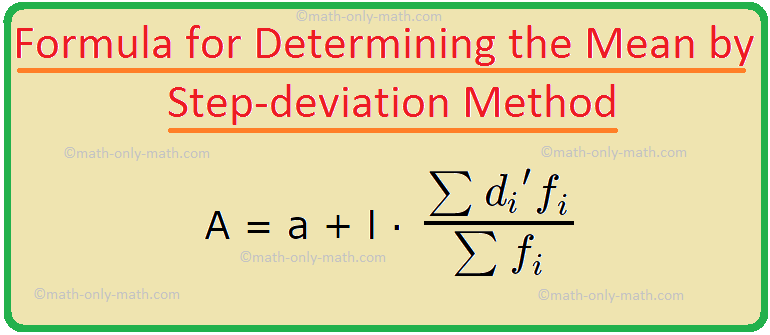Subscribe to our ▶️ YouTube channel 🔴 for the latest videos, updates, and tips.
Step-deviation Method
Here we will learn the step-deviation method for finding the mean of classified data.
We know that the direct method of finding the mean of classified data gives
Mean A = \(\frac{\sum m_{i}f_{i}}{\sum f_{i}}\)
where m1, m2, m3, m4, ……, mn are the class marks of the class intervals and f1, f2, f3, f4, …….., fn are the frequencies of the corresponding classes.
For class intervals of equal size of width l, let the assumed mean be a.
Taking di = mi – a, where mi = class mark of the ith class interval and di’ = \(\frac{d_{1}}{l}\) = \(\frac{m_{1} - a}{l}\), the above formula for mean becomes
A = \(\frac{\sum m_{i}f_{i}}{\sum f_{i}}\)
= \(\frac{\sum (l{d_{i}}' + a)f_{i}}{\sum f_{i}}\)
= \(\frac{\sum (l{d_{i}}'f_{i} + af_{i}) }{\sum f_{i}}\)
= \(\frac{\sum l{d_{i}}'f_{i} + \sum af_{i}}{\sum f_{i}}\)
= \(\frac{\sum af_{i}f_{i}}{\sum f_{i}}\) + \(\frac{\sum l{d_{i}}'f_{i}}{\sum f_{i}}\)
= \(\frac{a\sum f_{i}}{\sum f_{i}}\) + \(\frac{l\sum {d_{i}}'f_{i}}{\sum f_{i}}\)
Therefore, A = a + l ∙ \(\frac{\sum {d_{i}}'f_{i}}{\sum f_{i}}\)
This is the formula for determining the mean by step-deviation method.
Solved Examples on Finding Mean Using Step Deviation Method:
Find the mean of the following distribution using the step-deviation method.
Class Interval
0 - 8
8 - 16
16 - 24
24 - 32
32 - 40
40 - 48
Frequency
10
20
14
16
18
22
Solution:
Here, the intervals are of equal size. So we can apply the step-deviation method, in which
A = a + l ∙ \(\frac{\sum {d_{i}}'f_{i}}{\sum f_{i}}\)
where a = assumed mean,
l = common size of class intervals
fi = frequency of the ith class interval
di’ = \(\frac{m_{1} - a}{l}\), mi being the calss mark of the ith class interval.
Putting the calculated values in a table, we have the following.
|
Class Intervals |
Class Mark (mi) |
Frequency (fi) |
di = mi - a = mi - 28 |
di’= \(\frac{d_{i}}{l}\) = \(\frac{d_{i}}{8}\) |
di’fi |
|
0 - 8 |
4 |
10 |
-24 |
-3 |
-30 |
|
8 - 16 |
12 |
20 |
-16 |
-2 |
-40 |
|
16 - 24 |
20 |
14 |
-8 |
-1 |
-14 |
|
24 - 32 |
28 |
16 |
0 |
0 |
0 |
|
32 - 40 |
36 |
18 |
8 |
1 |
18 |
|
40 - 48 |
44 |
22 |
16 |
2 |
44 |
|
\(\sum f_{i}\) = 100 |
\(\sum {d_{i}}'f_{i}\) = -22 |
Therefore, A = a + l ∙ \(\frac{\sum {d_{i}}'f_{i}}{\sum f_{i}}\)
= 28 + 8 ∙ \(\frac{-22}{100}\)
= 28 – 1.76
= 26.24.
2. Find the mean percentage of the work completed for a project in a country from the following frequency distribution by using the step-deviation method.
Solution:
The frequency table with overlapping class intervals is as follows.
Taking the assumed mean a = 50, the calculations will be as below.
|
Class Intervals |
Class Mark (mi) |
di = mi - a = mi - 50 |
di’ = \(\frac{m_{1} - a}{l}\) = \(\frac{m_{1} - 50}{20}\) |
Frequency (fi) |
di’fi |
|
0 - 20 |
10 |
-40 |
-2 |
15 |
-30 |
|
20 - 40 |
30 |
-20 |
-1 |
45 |
-45 |
|
40 - 60 |
50 |
0 |
0 |
15 |
0 |
|
60 - 80 |
70 |
20 |
1 |
17 |
17 |
|
80 - 100 |
90 |
40 |
2 |
8 |
16 |
\(\sum f_{i}\) = 100
\(\sum {d_{i}}'f_{i}\) = -42
Therefore, mean = a + l ∙ \(\frac{\sum {d_{i}}'f_{i}}{\sum f_{i}}\)
= 50 + 20 × \(\frac{-42}{100}\)
= 50 - \(\frac{42}{5}\)
= 50 – 8.4
= 41.6.
From Step-deviation Method to HOME PAGE
Didn't find what you were looking for? Or want to know more information about Math Only Math. Use this Google Search to find what you need.



New! Comments
Have your say about what you just read! Leave me a comment in the box below. Ask a Question or Answer a Question.